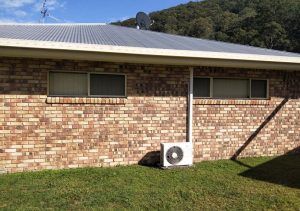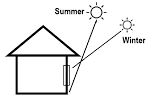All wars are either won or lost before the battle begins. One of my frequent quotes is that “a home’s thermal performance is determined long before the house is built”. Most outcomes are predictable and rarely come as a surprise to those who see the patterns. Good planners always start with the end in mind. Even with innovative projects that have never been undertaken before, building with predetermined outcomes clearly identified, and, how those objectives will be achieved, will most likely produce the desired product well before the physical building begins. How do we know we will be successful in our endeavours? Because success is achieved at the planning stage and not on the battlefield or construction site.
 To produce a building that requires minimal energy consumption it needs to be inherently thermally comfortable. A dwelling that requires frequent heating or cooling to keep the temperatures in what I call the “sweet spot”, is an energy guzzler and who wants one of those? Nobody, … that’s who. Let mother nature do most of the “thermal heavy lifting” by buying, building, or renovating a dwelling with the “shopping list” of expectations/objectives to be met.
To produce a building that requires minimal energy consumption it needs to be inherently thermally comfortable. A dwelling that requires frequent heating or cooling to keep the temperatures in what I call the “sweet spot”, is an energy guzzler and who wants one of those? Nobody, … that’s who. Let mother nature do most of the “thermal heavy lifting” by buying, building, or renovating a dwelling with the “shopping list” of expectations/objectives to be met.
There are several factors that will determine a home’s thermal performance including the climate zone, latitude, altitude, distance from the sea and local topography. All this information is specific to any site location including where the sun is going to be at any given time on any given day. A general idea of a typical temperature at any location can be assumed whilst considering data from previous years. It doesn’t take long to realise that it is warmer in summer and colder in winter in every location and that there is less exposure to the sun in winter, when you want it most, and more exposure to the sun in the summer, when you want it least. The summer days are longer, therefore more sun exposure and the winter days are shorter, therefore less sun exposure. No one should be shocked or surprised to find the sun shining relentlessly through a giant western window on a 43-degree summer afternoon if you should decide to buy or build such a thermal catastrophe.
 We elected not to have any windows on our western wall and only small but long windows up high on our eastern side. (See picture) The sun is the greater source of heat energy for our homes although the ground temperatures do dictate temperatures inside homes if they are built on the ground. Orientating a home efficiently, that is, correctly selecting its angle to the equator is of utmost importance. Coupled with the design, the selection and placement of thermal mass building materials, insulation, window type, size and location, all play a major role. But how do we know, throughout the seasons, how our home will thermally perform? We know because the sun moves through the sky like clockwork and is never fast or slow and is always where it should be, … every time, … without exception.
We elected not to have any windows on our western wall and only small but long windows up high on our eastern side. (See picture) The sun is the greater source of heat energy for our homes although the ground temperatures do dictate temperatures inside homes if they are built on the ground. Orientating a home efficiently, that is, correctly selecting its angle to the equator is of utmost importance. Coupled with the design, the selection and placement of thermal mass building materials, insulation, window type, size and location, all play a major role. But how do we know, throughout the seasons, how our home will thermally perform? We know because the sun moves through the sky like clockwork and is never fast or slow and is always where it should be, … every time, … without exception.
We can calculate when the sun will rise in any location at any time into the future or at any time in the past at any location. We know how high or low the sun will be in the sky at any given time at any given location. We know how many hours of sunlight will occur on every day at every location after factoring in local conditions including topography. The path and characteristics of the sun has been studied in much detail. We can benefit by using that information to reduce our energy expenses as well as for our thermal comfort.
The sun has a set and predictable path over the Earth from the summer solstice to the winter solstice when it restarts the predictable cycle again. The word “solstice” comes from the Latin word “solstitium” which means “sun” and “stand still” because that is what appears to happen at the time of the solstice. As we approach the winter solstice the days become shorter and shorter as the sun heads further from our location. The winter solstice is the shortest day of the year. After the winter solstice the days begin to become longer and longer again until the summer solstice which is the longest day of the year. The summer solstice in the northern hemisphere occurs at the same time as the winter solstice in the southern hemisphere and the winter solstice in the northern hemisphere occurs at the same time as the summer solstice in the southern hemisphere. The seasons are a mirror opposite on either side of the equator.
 The summer solstice in the southern hemisphere usually occurs on December 22 but it may happen on December 21 or December 23, and it will occur at the same time as the winter solstice in the northern hemisphere. At this time the sun appears to stand still in the Crux Constellation in the south, that is the vicinity of the Southern Cross, for three days and on the 25th of December it moves one-degree northwards as the days begin their gradual reduction in length and warmth as the days in the northern hemisphere become longer and warmer. The rebirth of the sun for those in north of the equator. This occurs for those who are south of the equator on (or around) 21st of June. At each solstice the sun has gone as far north or south of the equator as it will travel, and the cycle begins again. The extremes in sun exposure happen the further you are removed north or south from the equator. There is a time, twice a year, that the length of both day and night are the same. That is 12 hours of daylight and 12 hours of night. These are called the time of the equinox and occur when the sun is in between the two “Tropics”, that is when it is perfectly over the equator. This occurs on (or about) the 21st of March and is known as the Vernal Equinox and again on (or about) the 23rd of September and is known as the Autumnal Equinox.
The summer solstice in the southern hemisphere usually occurs on December 22 but it may happen on December 21 or December 23, and it will occur at the same time as the winter solstice in the northern hemisphere. At this time the sun appears to stand still in the Crux Constellation in the south, that is the vicinity of the Southern Cross, for three days and on the 25th of December it moves one-degree northwards as the days begin their gradual reduction in length and warmth as the days in the northern hemisphere become longer and warmer. The rebirth of the sun for those in north of the equator. This occurs for those who are south of the equator on (or around) 21st of June. At each solstice the sun has gone as far north or south of the equator as it will travel, and the cycle begins again. The extremes in sun exposure happen the further you are removed north or south from the equator. There is a time, twice a year, that the length of both day and night are the same. That is 12 hours of daylight and 12 hours of night. These are called the time of the equinox and occur when the sun is in between the two “Tropics”, that is when it is perfectly over the equator. This occurs on (or about) the 21st of March and is known as the Vernal Equinox and again on (or about) the 23rd of September and is known as the Autumnal Equinox.
We do know where the sun is going to be on everyday of the year. By facing the longest part of your home accordingly and building eves to block or allow sun access throughout the seasons, you can passively use Mother Nature’s natural desire to keep your home energy efficient and thermally comfortable.
Instructional Video Real Estate
Get your FREE copy of “Savvy Up and Save” here >>>LEARN MORE>>>
Moreton Bay residents can access weekly tips from John on Community Radio 101.5 FM Friday Mornings at 10:10am
John Lynn
